1780 Voyages POLYNESIA Captain Cook Islands Tahiti Pacific Ocean Patagonia 1sted
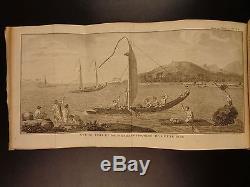


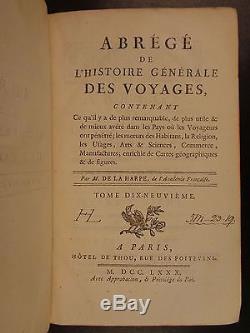
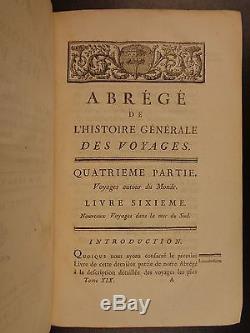
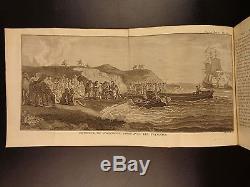
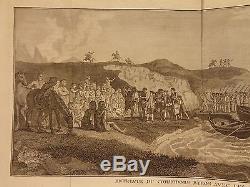
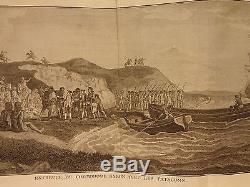



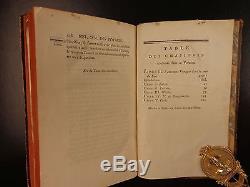

1780 Voyages POLYNESIA Captain Cook Islands Tahiti Pacific Ocean Patagonia 1. Expeditions of Cook, Wallis, Byron, & MORE! Abbe Prevost ; Victor Delpueche de Comeiras. Abrégé de l'Histoire générale des voyages : contenant ce qu'il y a de plus remarquable, de plus utile & de mieux avéré dans les pays où les voyageurs ont pénétre : les murs des habitans, les religion, les usages, arts & sciences, commerce, manufactures : enrichie de cartes géographiques & de figures. A Paris : Hôtel de Thou...
Meeting of Commodore Byron with the Patagonians (folding). View of natives and their huts (folding). Captain Wallis meeting Queen Oberea on Tahiti (folding).
View of several boats near the island of Tahiti (folding). Wear as seen in photos. Tight and secure leather binding. Complete with all 439 pages; plus indexes, prefaces, and such.
8in X 5in (20cm x 13cm). Jean-François de La Harpe (November 20, 1739 February 11, 1803) was a French playwright, writer and critic. La Harpe was born in Paris of poor parents. His father, who signed himself Delharpe, was a descendant of a noble family originally of Vaud.
Left an orphan at the age of nine, La Harpe was taken care of for six months by the Sisters of Charity, and his education was provided for by a scholarship at the Collège d'Harcourt, now known as the Lycée Saint-Louis. When nineteen he was imprisoned for some months on the charge of having written a satire against his protectors at the college. He was imprisoned at For-l'Évêque. [1] La Harpe always denied his guilt, but this culminating misfortune of an early life spent entirely in the position of a dependent possibly had something to do with the bitterness he evinced in later life. In 1763, his tragedy of Warwick was played before the court.
This, his first play, was perhaps the best he ever wrote. The many authors whom he afterwards offended were always able to observe that the critic's own plays did not reach the standard of excellence he set up. Timoleon (1764) and Pharamond (1765) were box-office and critical failures. Mélanie was a better play, but was never represented. The success of Warwick led to a correspondence with Voltaire, who conceived a high opinion of La Harpe, even allowing him to correct his verses.In 1764, La Harpe married the daughter of a coffee house keeper. This marriage, which proved very unhappy and was dissolved, did not improve his position. They were very poor, and for some time were guests of Voltaire at Ferney. When, after Voltaire's death, La Harpe in his praise of the philosopher ventured on some reasonable, but rather ill-timed, criticism of individual works, he was accused of treachery to one who had been his constant friend. He was a born fighter and had little mercy on the authors whose work he handled.
But he was himself violently attacked, and suffered under many epigrams, especially those of Lebrun-Pindare. No more striking proof of the general hostility can be given than his reception in 1776 at the Académie française, which Sainte-Beuve calls his "execution". Marmontel, who received him, used the occasion to eulogize La Harpe's predecessor, Charles Pierre Colardeau, especially for his pacific, modest and indulgent disposition.The speech was punctuated by the applause of the audience, who chose to regard it as a series of sarcasms on the new member. Eventually La Harpe was compelled to resign from the Mercure, which he had edited from 1770. On the stage he produced Les Barmecides (1778), Philoctete, Jeanne de Naples (1781), Les Brames (1783), Coriolan (1784), Virginie (1786).
In 1786, he began delivering a course of literature at the newly established Lycée. In these lectures, published as the Cours de littérature ancienne et moderne, La Harpe is considered to have been at his best, finding a standpoint more or less independent of contemporary polemics.
He is said to have been inexact in dealing with the ancients and that he had only a superficial knowledge of the Middle Ages, but he was excellent in his analysis of seventeenth-century writers. Before the rise of Racine, Sainte-Beuve found La Harpe to the best critic of the French school of tragedy. La Harpe was a disciple of the "philosophes", supporting their extreme party through the excesses of 1792 and 1793. Nonetheless, in April 1794, La Harpe was seized as a "suspect".
In prison he underwent a spiritual crisis which he described in convincing language, emerging an ardent Catholic and a political reactionary. When he resumed his chair at the Lycée, he attacked his former friends in politics and literature. In these letters he surpassed the brutalities of the Mercure.
He contracted a second marriage, which was dissolved after a few weeks by his wife. He died on February 11, 1803 in Paris, leaving in his will an incongruous exhortation to his fellow countrymen to maintain peace and concord. Among his posthumous works was a Prophétie de Cazotte, which Sainte-Beuve pronounced his best work.
It is a somber description of a dinner-party of notables long before the Revolution, in which Jacques Cazotte is made to prophesy the frightful fates awaiting the various individuals of the company. Among his works not already mentioned are: Commentaire sur Racine (17951796), published in 1807; Commentaire sur le théâtre de Voltaire of earlier date (published posthumously in 1814); and an epic poem La Religion (1814). His Cours de littérature has been often reprinted; a notice by Pierre Daunou prefixes the 18251826 edition. The item "1780 Voyages POLYNESIA Captain Cook Islands Tahiti Pacific Ocean Patagonia 1sted" is in sale since Tuesday, April 12, 2016.
This item is in the category "Books\Antiquarian & Collectible". The seller is "schilb_antiquarian_books" and is located in Columbia, Missouri. This item can be shipped worldwide.
- Binding: Leather
- Subject: Exploration & Travel
- Topic: Australia, Oceania
- Special Attributes: 1st Edition
- Origin: European
- Original/Reproduction: Original
- Year Printed: 1780
- Printing Year: 1780

